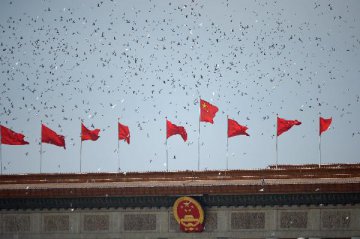China's Five-Year Plan from 2016 to 2020, aiming at a more sustainable and balanced way of development, offers a model to be widely discussed by world economists.
The plan, setting a target of "maintaining a medium-high speed of growth," aims to double its 2010 GDP and per capita income by 2020, according to a communique issued following the Fifth Plenum of the 18th Communist Party of China (CPC) Central Committee.
"For China to double 2010 GDP and the per capita income of both urban and rural residents by 2020, the annual growth for the 2016-2020 period must be at least 6.5 percent," Chinese President Xi Jinping said in a statement.
As China's economy enters the "new normal," featuring slower yet healthier economic growth, it takes time and space for China to digest industrial over-capacity, restructure the economy and shift to an innovation-driven mode.
"The growth pattern is truly changing from an investment, export-led economy to a domestic consumption, services-driven one, leading to slower albeit healthier growth," said Livio Ribeiro, an economist at the Getulio Vargas Foundation in Brazil, in an interview with Xinhua.
A growth rate of less than 7 percent, or even about 6.5 percent, is an appropriate target that will still make China a major contributor to global economic growth, said Nicholas Lardy, a senior fellow with Peterson Institute for International Economics.
GREEN DEVELOPMENT
China will stick to green development and strive to improve the environment, according to the communique. It will promote clean industrial production, low-carbon development and energy conservation to ensure sustainable growth in the next five years, the communique added.
The focus is to seek growth through economic transformation, optimizing industrial structure, improving the environment and enhancing quality and efficiency, Xi noted. Creating a new "ecological civilization" rather than focusing on the GDP growth will become a new priority of the Chinese government toward 2020, U.S. economist Laurence J. Brahm told Russia's Sputnik News Agency.
The CPC will herald an era of "ecological civilization", calling for a new type of growth that is more holistic and balanced than focusing on high speed growth of industrial development as seen in the past decade, Brahm explained.
The service sector's share in the GDP will continue to increase and consumption's contribution to economic growth will rise significantly, the communique predicted. "Development must rest on the basis of innovation," it said.
For example, the innovative development of the Internet has penetrated all sectors of the the society and the industry, and has directly changed China's economic and social structure, said Zhou Zhaocheng, adjunct associate professor of Nanyang Technological University.
Therefore, the policy on innovative development of the Internet, adopted in the 13th Five-Year Plan, will have a far-reaching influence on China's future economic development, Zhou added.
If China continues to adhere to its policies based on a "new normal," the people's livelihood will continue to be improved, said Kiyoyuki Seguchi, research director of Japanese think tank Canon Institute for Global Studies.
OPENING WIDER TO THE WORLD
China will accelerate its opening-up of the capital market, and further opening-up of the service sector, including banking, insurance, securities and nursing homes, to foreign investment, the communique said. In addition, it will continue to promote the "Belt and Road" initiative through cooperation with countries and regions along the routes, and participate in global industrial and equipment manufacturing cooperation, according to the communique.

The "" initiative creates a new opening-up pattern towards both the East and the West, economists said. If China wants to continue to grow at a medium-high rate, it will need to open up the economy more widely to international trade and investment, said David Dollar, a leading China expert with the Brookings Institution.
A more opening up China creates more opportunities for goods, services and investment from other countries, Tang Zhimin, director of China ASEAN Studies under Bangkok-based Panyapiwat Institute of Management, told Xinhua. "Opening up the domestic market is a powerful tool of reform that can benefit China," economist and deputy director of the Australia-China Relations' Institute James Laurenceson told Xinhua.
Though there are some sectors that remain protected and these sectors will be a focus of reform in the coming five years, Laurenceson expected that lowering barriers to entry for private sector firms, both domestic and foreign, will be a major focus of the 13th Five-Year Plan.





















Latest comments